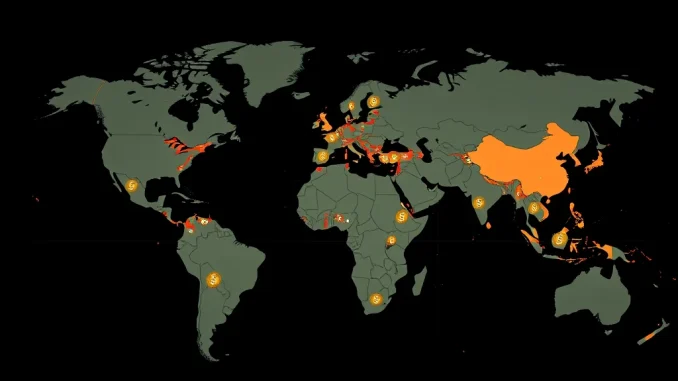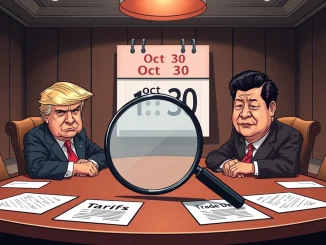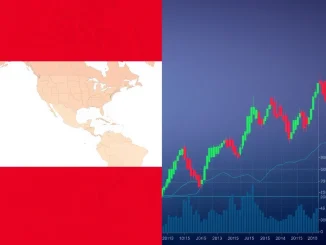
Buckle up, crypto enthusiasts and market watchers! The winds of economic change are blowing, and they could bring significant shifts to the global landscape, potentially impacting everything from traditional markets to the digital asset realm. Whispers from Washington suggest a dramatic move by the Trump administration that could send ripples across the world: a massive global tariff imposition.
What’s the Buzz About Global Tariffs?
Imagine a world where almost every product crossing borders faces a hefty tax. That’s precisely what’s on the table. According to a Wall Street Journal report cited by Fortune, advisors within the Trump administration are seriously considering slapping a global tariffs of up to 20% on imports from nearly every nation. This isn’t just a minor tweak; it’s a potentially seismic shift in international trade policy. Let’s break down what this could mean:
- Broad Scope: This isn’t targeted at a specific country or industry. It’s a worldwide net, encompassing goods from almost all nations.
- Significant Percentage: A 20% tariff is substantial. It means a product costing $100 to import would now cost $120, directly impacting consumer prices and business costs.
- Retaliation Risk: The report mentions that retaliatory tariffs are also under consideration. This hints at a potential trade war scenario, where countries hit back with their own tariffs, escalating tensions and market uncertainty.
This news comes as the global economy is already navigating complex waters. From inflation concerns to supply chain disruptions, adding a layer of widespread tariffs could introduce further volatility and unpredictability. For those invested in cryptocurrencies, which are often seen as alternative assets in times of economic uncertainty, understanding these macroeconomic shifts is crucial.
Why is the Trump Administration Considering This Import Tax?
While the exact motivations are still unfolding, several factors could be at play when considering this significant import tax. Historically, the Trump administration has advocated for policies aimed at:
- Boosting Domestic Industries: Tariffs make imported goods more expensive, theoretically making domestically produced goods more competitive. This ‘America First’ approach aims to incentivize local manufacturing and job creation.
- Reducing Trade Deficits: By making imports pricier, the administration might be aiming to decrease the amount of goods imported, thereby narrowing the trade deficit.
- Leveraging Trade as a Political Tool: Tariffs can be used as leverage in trade negotiations, pressuring other countries to change their policies.
However, the economic consequences of such a broad tariff policy are complex and often debated. While proponents argue for domestic benefits, critics point to potential harms like increased consumer prices, reduced competitiveness for export-oriented industries, and damage to international relationships.
Potential Economic Impact: What Could Happen?
The introduction of global tariffs of this magnitude could trigger a cascade of economic effects. Let’s consider some potential scenarios:
| Potential Impact | Description |
|---|---|
| Increased Consumer Prices | Imported goods become more expensive due to tariffs, and this cost is often passed on to consumers in the form of higher prices for everyday goods. |
| Reduced Trade Volume | Higher tariffs can discourage international trade, leading to a decrease in the volume of goods exchanged between countries. |
| Retaliatory Tariffs and Trade Wars | Other countries may retaliate by imposing their own tariffs on US goods, leading to a cycle of escalating trade barriers – a trade war. |
| Supply Chain Disruptions | Tariffs can disrupt global supply chains, making it more expensive and complicated for businesses to source materials and manufacture products. |
| Market Volatility | Uncertainty surrounding trade policies can lead to increased volatility in financial markets, including stock markets and potentially cryptocurrency markets. |
For cryptocurrency holders, the potential for increased market volatility is a key consideration. While some might see crypto as a safe haven asset during economic turmoil, others might anticipate broader market downturns impacting all asset classes.
How Could This Affect the Crypto Market?
While not directly targeting the cryptocurrency market, the broader economic impact of global tariffs can indirectly influence the crypto space. Here’s how:
- Inflationary Pressures: Increased import costs can contribute to inflation. In inflationary environments, some investors may turn to cryptocurrencies as a hedge against traditional currency devaluation.
- Economic Uncertainty: Periods of economic uncertainty often drive investors to seek alternative assets. Cryptocurrency, with its decentralized nature and limited supply (for some coins like Bitcoin), might become more attractive.
- Risk-Off Sentiment: Conversely, significant economic disruption can trigger a ‘risk-off’ sentiment across all markets. Investors might reduce exposure to all perceived risk assets, including cryptocurrencies, in favor of safer havens like cash or government bonds.
- Geopolitical Implications: Trade tensions and potential trade wars can reshape global power dynamics. Cryptocurrencies, being borderless and outside traditional financial systems, could see increased adoption in regions affected by these geopolitical shifts.
It’s important to remember that the cryptocurrency market is influenced by a multitude of factors, and macroeconomic events like tariff policies are just one piece of the puzzle. However, understanding these broader economic currents is essential for navigating the crypto landscape.
Navigating the Trade War Threat: Actionable Insights
So, what can you do as a crypto investor or enthusiast in light of this potential trade war scenario?
- Stay Informed: Keep a close eye on developments in trade policy. News from sources like the Wall Street Journal, Fortune, and reputable financial news outlets will be crucial.
- Diversify Your Portfolio: Diversification is always a sound strategy, especially in uncertain times. Don’t put all your eggs in one basket, whether it’s a single cryptocurrency or asset class.
- Risk Management: Assess your risk tolerance and adjust your portfolio accordingly. Consider strategies to manage potential downside risks in volatile market conditions.
- Long-Term Perspective: Remember that market fluctuations are normal. Focus on your long-term investment goals and avoid making impulsive decisions based on short-term news cycles.
- Understand Macroeconomic Trends: Broaden your understanding of macroeconomic factors that can influence the crypto market. Events like tariff policies, inflation reports, and interest rate decisions can all have ripple effects.
The Road Ahead: Uncertainty and Opportunity
The prospect of the Trump administration implementing widespread global tariffs introduces a significant element of uncertainty into the global economic outlook. While the long-term consequences are still unclear, it’s evident that such a policy shift could have far-reaching effects, impacting everything from international trade relationships to consumer prices and financial markets, including the cryptocurrency space.
For those in the crypto world, staying vigilant, informed, and adaptable is key. While uncertainty can be unsettling, it also often presents opportunities. By understanding the potential implications of these macroeconomic shifts, you can better position yourself to navigate the evolving landscape and make informed decisions in the dynamic world of cryptocurrency and beyond.



